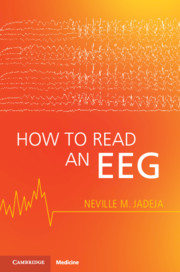Book contents
- How to Read an EEG
- How to Read an EEG
- Copyright page
- Dedication
- Contents
- Figure Contributions
- Foreword
- Preface
- How to Read This Book
- Part I Basics
- Part II Interpretation
- Chapter 9 Approach to EEG Reading
- Chapter 10 Background
- Chapter 11 Foreground (How to Describe an Abnormality)
- Chapter 12 Common Artifacts
- Chapter 13 Normal Variants
- Chapter 14 Sporadic Abnormalities
- Chapter 15 Repetitive Abnormalities
- Chapter 16 Ictal Patterns (Electrographic Seizures)
- Chapter 17 Activation Procedures
- Part III Specific Conditions
- Appendix How to Write a Report
- Index
- References
Chapter 10 - Background
from Part II - Interpretation
Published online by Cambridge University Press: 24 June 2021
- How to Read an EEG
- How to Read an EEG
- Copyright page
- Dedication
- Contents
- Figure Contributions
- Foreword
- Preface
- How to Read This Book
- Part I Basics
- Part II Interpretation
- Chapter 9 Approach to EEG Reading
- Chapter 10 Background
- Chapter 11 Foreground (How to Describe an Abnormality)
- Chapter 12 Common Artifacts
- Chapter 13 Normal Variants
- Chapter 14 Sporadic Abnormalities
- Chapter 15 Repetitive Abnormalities
- Chapter 16 Ictal Patterns (Electrographic Seizures)
- Chapter 17 Activation Procedures
- Part III Specific Conditions
- Appendix How to Write a Report
- Index
- References
Summary
Symmetry: it may be symmetric, mildly asymmetric, or markedly asymmetric. Mild asymmetry of the dominant hemisphere may be physiologic. Continuity: it may be continuous, nearly continuous, discontinuous, or burst-suppressed. Attenuation is the periodic dampening of amplitudes by less than half the remaining background, while suppression is when the amplitude falls below 10 uV. Voltage: it may be normal (above 20 uV), low voltage (20-10 uV), or suppressed (less than 10 uV). Organization: a well-organized background has an anterior-posterior gradient, predominantly alpha frequencies, and a reactive posterior dominant rhythm (PDR). The loss of either or all these features results in a deterioration in background organization. Variability and reactivity: variability refers to spontaneous changes in the background, while variability refers to changes in response to external stimulation. Always specify the stimulation used and advance it in a graded manner. Variability and reactivity of the background are associated with favorable clinical outcomes. Presence of stage II sleep architecture such as spindles and K complexes should be noted
Information
- Type
- Chapter
- Information
- How to Read an EEG , pp. 67 - 78Publisher: Cambridge University PressPrint publication year: 2021
